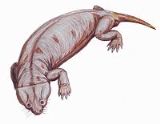
Cistecephalus
Encyclopedia
Cistecephalus was a small, specialised, burrowing dicynodont
, possibly with habits similar to a modern mole
. The head was flattened and wedge-shaped, the body short, and the forelimbs very strong, with similarities in structure to the forelimb of modern burrowing mammals.
It was one of the first genera of dicynodonts to be described, by Richard Owen
, in 1876.
Cistecephalus is so far known from the Cistecephalus Assemblage Zone
of the South Africa
n Karoo
, as well as from Zambia
and India
. A very similar genus, Kawingasaurus
, is known from the Kawinga Formation of Tanzania, which is probably equivalent in age to the Cistecephalus zone.
Cistecephalus was about 33 centimetres (13 in) in length.
Dicynodont
Dicynodontia is a taxon of anomodont therapsids or mammal-like reptiles. Dicynodonts were small to large herbivorous animals with two tusks, hence their name, which means 'two dog tooth'...
, possibly with habits similar to a modern mole
Mole (animal)
Moles are small cylindrical mammals adapted to a subterranean lifestyle. They have velvety fur; tiny or invisible ears and eyes; and short, powerful limbs with large paws oriented for digging. The term is especially and most properly used for the true moles, those of the Talpidae family in the...
. The head was flattened and wedge-shaped, the body short, and the forelimbs very strong, with similarities in structure to the forelimb of modern burrowing mammals.
It was one of the first genera of dicynodonts to be described, by Richard Owen
Richard Owen
Sir Richard Owen, FRS KCB was an English biologist, comparative anatomist and palaeontologist.Owen is probably best remembered today for coining the word Dinosauria and for his outspoken opposition to Charles Darwin's theory of evolution by natural selection...
, in 1876.
Cistecephalus is so far known from the Cistecephalus Assemblage Zone
Cistecephalus Assemblage Zone
The Cistecephalus Assemblage Zone is a geological stratum and a faunal zone of the Beaufort Group, of the South African Karoo. The name refers to Cistecephalus, a genus of small burrowing, mole-like reptile, whose fossils have been found in that structure....
of the South Africa
South Africa
The Republic of South Africa is a country in southern Africa. Located at the southern tip of Africa, it is divided into nine provinces, with of coastline on the Atlantic and Indian oceans...
n Karoo
Karoo
The Karoo is a semi-desert region of South Africa. It has two main sub-regions - the Great Karoo in the north and the Little Karoo in the south. The 'High' Karoo is one of the distinct physiographic provinces of the larger South African Platform division.-Great Karoo:The Great Karoo has an area of...
, as well as from Zambia
Zambia
Zambia , officially the Republic of Zambia, is a landlocked country in Southern Africa. The neighbouring countries are the Democratic Republic of the Congo to the north, Tanzania to the north-east, Malawi to the east, Mozambique, Zimbabwe, Botswana and Namibia to the south, and Angola to the west....
and India
India
India , officially the Republic of India , is a country in South Asia. It is the seventh-largest country by geographical area, the second-most populous country with over 1.2 billion people, and the most populous democracy in the world...
. A very similar genus, Kawingasaurus
Kawingasaurus
Kawingasaurus is an extinct genus of non-mammalian synapsid.-References:*...
, is known from the Kawinga Formation of Tanzania, which is probably equivalent in age to the Cistecephalus zone.
Cistecephalus was about 33 centimetres (13 in) in length.

